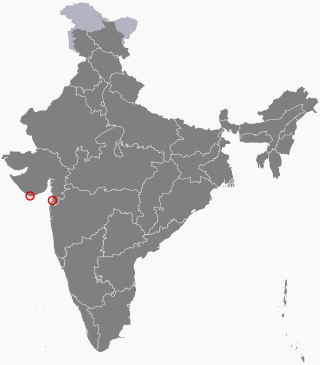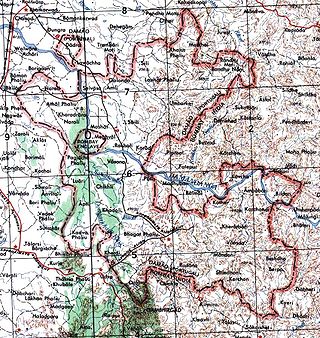
Nigel Keith Anthony Standish Vaz is a British politician who served as the Labour Party Member of Parliament (MP) for Leicester East for 32 years, from 1987 to 2019. He is the UK Parliament's longest-serving British Asian MP.

Daman and Diu was a union territory in northwestern India. With an area of 112 km2 (43 sq mi), it was the smallest administrative subdivision of India on the mainland. The territory comprised two districts, Daman and Diu Island, geographically separated by the Gulf of Khambat. The state of Gujarat and the Arabian Sea bordered the territory. A Portuguese colony since the 1500s, these territories were taken over by India with the Annexation of Goa in 1961. Daman and Diu were administered as part of the union territory of Goa, Daman and Diu between 1961 and 1987. After the Goa Opinion Poll, they became separate union territories. In 2019, a legislation was passed to merge the union territories of Daman and Diu with its neighbouring union territory, Dadra and Nagar Haveli, to form the new union territory of Dadra and Nagar Haveli and Daman and Diu with effect from 26 January 2020.

The Bardoli Satyagraha, was a farmers' agitation and nationalist movement in India against the increased taxation of farmers by the colonial government. It demanded a cancellation of the 22% tax hike being levied in Bombay Presidency. The movement began on 12 June 1928. It was eventually led by Sardar Vallabhbhai Patel, and its success gave rise to Patel becoming one of the main leaders of the independence movement.

Amona was an Israeli outpost in the central West Bank. Located on a hill overlooking Ofra within the municipal boundaries of the Mateh Binyamin Regional Council, the village was founded in 1995 on privately owned Palestinian land. As of 2012, its population was around 200. As of October 2013, the outpost lodged 42 families. It was evacuated completely in February 2017 in compliance with a ruling by the Israeli Supreme Court.
Daman district, is one of four districts of the Indian union territory of Dadra and Nagar Haveli and Daman and Diu. It is located on the west coast of India and is surrounded by the Valsad district of the Gujarat state to the north, east and south, and by the Arabian Sea to the west. The district covers an area of 72 square kilometers and had a population of 191,173 as of the 2011 census, an increase of 69.256% from the 2001 census. The district headquarters is Daman. Previously, the territorial headquarters were in Panjim when it was jointly administered as Goa, Daman, and Diu until the time of the Konkani language agitation.

Mohan Sanjibhai Delkar was an Indian politician and tribal rights advocate, who was elected seven times as a member of Lok Sabha from Dadra and Nagar Haveli constituency, in the Union Territory of Dadra & Nagar Haveli and Daman & Diu. He had been part of Indian National Congress (INC), Bharatiya Janata Party (BJP) and Janata Dal (United) (JDU) at various times, and had also founded his own party Bharatiya Navshakti Party for some period.

The Warli or Varli are an indigenous tribe (Adivasi) of western India, living in mountainous as well as coastal areas along the Maharashtra-Gujarat border and surrounding areas. They have their own animistic beliefs, life, customs and traditions, and as a result of acculturation they have adopted many Hindu beliefs. The Warli speak the unwritten Varli language which belongs to the southern zone of the Indo-Aryan languages. Waralis have sub castes such as Murde varli, Davar varali.
Overdale was a small residential district in downtown Montreal that became a famous symbol of the struggle between urban conservationists and land developers.

The annexation of Dadra and Nagar Haveli was the conflict in which the territories of Dadra and Nagar Haveli passed from Portuguese rule to independent rule, with Indian allegiance, in 1954.

Komaram Bheem (1901–1940), alternatively Kumram Bheem, was a revolutionary leader in Hyderabad State of British India from the Gond tribes. Bheem, in association with other Gond leaders, led a protracted low intensity rebellion against the feudal Nizams of Hyderabad in the eastern part of the princely state during the 1930s, which contributed in the culmination of the Telangana Rebellion of 1946.
Forced eviction in China refers to the practice of involuntary land requisitions from the citizenry, typically in order to make room for development projects. In some instances, government authorities work with private developers to seize land from villagers, with compensation below the market price. In many cases, they are also offered alternative housing instead of or on top of monetary compensation. Forced evictions are particularly common in rural areas, and are a major source of unrest and public protest. By some estimates, up to 65 percent of the 180,000 annual mass conflicts in China stem from grievances over forced evictions. Some citizens who resist or protest the evictions have reportedly been subjected to harassment, beatings, or detention.
The Muthanga Incident was an incident in Kerala India, where police fired on the Adivasis in the Muthanga village of Wayanad district, Kerala. On 19 February 2003, the Adivasis had gathered under Adivasi Gothra Maha Sabha (AGMS) to protest the Kerala Government's delay in allotting them land, which had been contracted in October 2001. During the protest, Kerala Police fired 18 rounds resulting in two immediate fatalities. In a subsequent statement, the Government placed the official death toll at five. Footage of the firing was aired on several news programs.

Praful Khoda Patel is an Indian politician, who is currently the administrator of the union territory of Dadra and Nagar Haveli and Daman and Diu and the union territory of Lakshadweep.

Binod Chaudhary is a Nepalese billionaire businessman, politician and philanthropist. He is the chairman and president of the Chaudhary Group (CG).

The Kheda Satyagraha of 1918 was a satyagraha movement in the Kheda district of Gujarat in India organised by Mahatma Gandhi during the period of the British Raj. It was a major revolt in the Indian independence movement. It was the second Satyagraha movement, which was launched 7 days after the Ahmedabad mill strike. After the successful Satyagraha conducted at Champaran in Bihar, Gandhi organised the movement to support peasants who were unable to pay the revenue because of famine and plague epidemic.
Events in the year 2020 in Palestine.

The Dominion Foundry Site is a group of heritage industrial buildings in Toronto, Ontario, Canada. The site was developed by Dominion Wheel & Foundries Limited, a rail parts manufacturer based in Toronto. Now publicly owned, the site is planned for sale and redevelopment. The plans for redevelopment by the Government of Ontario have been controversial, sparking public opposition.
Bulldozer justice is a term referring to the use of the bulldozer, an industrial machine, as a political tool and symbol in Indian politics, particularly in the politics of Uttar Pradesh, starting in 2017. This began with the evoking of the machine by UP Chief Minister Yogi Adityanath of the BJP. While bulldozers are routinely used across India to remove illegal constructions, the bulldozer has been portrayed as a symbol of law enforcement in addressing property-related crimes, communal violence rioters and alleged criminal activity. Demolition of structures has been increasingly reported in states with BJP leadership as a measure against illegal constructions. Following its usage in political messaging in Uttar Pradesh, the bulldozer was used in Madhya Pradesh to convey political messages aimed at showing a strong stance against criminals. Some narratives suggest that certain communities perceive the use of bulldozers as biased. In particular, properties belonging to and settlements primarily populated by Muslims have been disproportionately targeted. Critics also argue that giving up on the rule of law and adopting "bulldozer justice" is the initial move toward an authoritarian society. In such a society, the safety, life, and liberty of individuals would depend on the arbitrary decisions of state officials.













